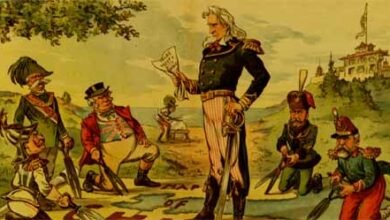
भौतिकी से संबंधित-119.
|
1. The imaginary line that passes through a focus and pole on a circular mirror is called? = Main axis. 2. According to the third law of motion, the force associated with action and reaction? = Should always be engaged on different items. 3. ‘Every action has a reaction in equal and opposite direction, whose law is this? = Newton’s third law of motion. 4. Due to which law of motion of Newton is it possible to swim in water? = Newton’s third law of motion. 5. ‘A body will remain in rest till there is no external force acting on it.’ Whose statement is this? = Newton. 6. If the velocity of an object is doubled? = The momentum is double and the kinetic energy becomes four times. 7. The frequency fluctuations of a sound source are called? = Doppler effect. 8. The number of times a particle vibrates in a second is called that number. = Frequency. 9. The attraction force acting between any two objects is proportional to the product of the masses of the objects and the distance between them? = Inversely proportional to the square. 10. Ampere is the unit of = Electric current. 11. What is the unit of pressure? = Pascal. 12. Not a vector amount? = Move. 13. Whose unit is Parsec? = Distance. 14. Ampere is the unit of = Electrical current. 15. What is the unit of work? = Joule 16. Light year unit? = Distance (9.46 × 10 to the power of 15). 17. What is a vector sign? = Speed. 18. Whose unit is not a Newton-meter? = Force. 19. ‘Curie’ is the name of whose entity? = Radioactive religiosity. 20. What is measured by cusec? = Flow of water. 21. How is the relative density measured? = Hydrometer. 22. The tendency of objects to resist change in their state of motion is called? = Inertia. 23. What are the types of inertia? = a. Inertia of pause b. Speed of inertia. 24. The product of mass and velocity of an object is called that object? = Momentum. 25. Friction always opposes what? = Relative Speed. 26. How many types of friction are there? = a. Static Friction b. Spiral Friction c. Rolling Friction. 27. How many types of forces are there? = a. Gravitational Force b. Electromagnetic Force c. Weak Force d. Strong force. 28. What are the types of electromagnetic force? = a. Static Electric Force b. Magnetic Force. 29. What is the unit for measuring distances of stars? = PARSEC. 30. Which instrument the angle of the crystal is measured? = Goniometer. ============= =========== ============ 1. वह काल्पनिक रेखा जो फ़ोकस एवं पोल से गुजरते हुए गोलकार दर्पण पर पड़ती है, वह कहलाती है? = मुख्य अक्ष. 2. गति के तीसरे नियम के अनुसार क्रिया तथा प्रतिक्रिया से सम्बद्ध बल? = हमेशा भिन्न-भिन्न वस्तुओं पर ही लगे होने चाहिए. 3. ‘प्रत्येक क्रिया के बराबर व विपरीत दिशा में एक प्रतिक्रिया होती है यह किसका नियम है? = न्यूटन के गति का तृतीय नियम. 4. जल में तैरना न्यूटन की गति के किस नियम के कारण सम्भव है? = न्यूटन के गति का तृतीय नियम. 5. ‘कोई पिण्ड तब तक विरामावस्था में ही बना रहेगा, जब तक उस पर कोई बाह्य बल कार्य नहीं करता है।’ यह कथन किसका है? = न्यूटन. 6. किसी वस्तु का वेग दुगुना कर दिया जाए तो? = संवेग दुगुना और गतिज ऊर्जा चार गुना हों जाती है. 7. किसी ध्वनि स्रोत की आवृत्ति में होने वाले उतार-चढ़ाव को कहते हैं? = डाप्लर प्रभाव. 8. कोई कण एक सेकेण्ड में जितने कम्पन करता है, उस संख्या को कहते हैं? = आवृति. 9. किसी दो वस्तुओं के बीच कार्य करने वाला आकर्षण बल वस्तुओं के द्रव्यमानों के गुणनफल के समानुपाती तथा उनके बीच की दूरी? = वर्ग के व्यत्क्रमानुपाती होता है. 10. एम्पियर किसका मात्रक है? = विद्युत धारा का. 11. दाब का मात्रक होता है? = पास्कल. 12. सदिश राशि नहीं है?= चाल. 13. पारसेक किसकी इकाई है? = दूरी. 14. एम्पियर किसका मात्रक है? = विधुत धारा. 15. कार्य का क्या मात्रक है? = जूल. 16. प्रकाश वर्ष इकाई है? = दूरी की (9.46×10 की घात 15). 17. एक सदिश राशि है? = संवेग. 18. किसकी इकाई न्यूटन-मीटर नहीं है? = बल. 19. ‘क्यूरी’ (Curie) किसकी इकाई का नाम है? = रेडियोऐक्टिवधर्मिता. 20. क्यूसेक से क्या मापा जाता है? = जल का बहाव. 21. आपेक्षिक घनत्व (Relative Density) की माप कैसे की जाती है? = हाइड्रोमीटर. 22. वस्तुओं द्वारा अपनी गति की अवस्था में परिवर्तन का प्रतिरोध करने की प्रवृत्ति को कहते हैं? = जड़त्व. 23. जड़त्व कितने प्रकार का होता है? = a. विराम का जड़त्व b. गति का जड़त्व. 24. किसी वस्तु के द्रव्यमान तथा वेग के गुणनफल को उस वस्तु का कहते हैं? = संवेग. 25. घर्षण सदैव किसका विरोध करता है? = सापेक्षिक गति. 26. घर्षण कितने प्रकार के होते हैं? = a. स्थैतिक घर्षण b. सर्पी घर्षण c.लोटनिक घर्षण. 27. बल कितने प्रकार के होते हैं? = गुरुत्वाकर्षण बल b.विद्युत चुम्बकीय बल c. दुर्बल बल d.प्रबल बल. 28. विद्युत चुम्बकीय बल कितने प्रकार के होते हैं? = a. स्थिर विद्युत बल b.चुम्बकीय बल. 29. तारों संबंधी दूरियाँ मापने का मात्रक होता है? = पारसेक (PARSEC). 30. किस यंत्र की सहायता से क्रिस्टल का कोण नापते हैं? = गोनियोमीटर.
|





